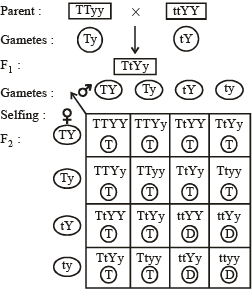Test: Heredity And Variation 6 - From Past 28 Years Questions - NEET MCQ
25 Questions MCQ Test - Test: Heredity And Variation 6 - From Past 28 Years Questions
A women with albinic father marries an albinic man. The proportion of her progeny is
[1994]
In a dihybrid cross AABB × aabb, F2 progeny of AABB, AABb, AaBB and AaBb occurs in the ratio of
[1994]
| 1 Crore+ students have signed up on EduRev. Have you? Download the App |
The process of mating between closely related individuals is
[1994]
A cross between pure tall Pea plant with green pods and dwarf Pea plant with yellow pods will produce short F2 plants out of 16
[1994]
A child of blood group O can not have parents of blood groups
[1994]
A fruitfly exhibiting both male and female traits is
[1994]
Genes located on Y-chromosome are
[1994]
When two genetic loci produce identical phenotypes in cis and trans position, they are considered to be
[1995]
Barr body in mammals represents
[1995]
The polytene chromosomes were discovered for the first time in
[1995]
The most striking example of point mutation is found in a disease called
[1995]
The change of the light-coloured variety of peppered moth (Biston betularia) to its darker variety (Biston carbonaria) is due to
[1995]
Alleles that produce independent effects in their heterozygous condition are called
[1996]
An individual exhibiting both male and female sexual characteristics in the body is known as
[1996]
Barr body in human female is formed by
[1996]
A person with 47 chromosomes due to an additional Y chromosome suffers from a condition called
[1996]
A man with a certain disease marries a normal woman. They have eight children (3 daughters and 5 sons). All the daughters suffer from their father's disease but none of the sons are affected. Which of the following mode of inheritance do you suggest for this disease?
[1996, 2005]
H.J.Muller was awarded Nobel Prize for his
[1996]
A fruit fly is heterozygous for sex-linked genes. When mated with a normal female fruit fly, the male-specific chromosome will enter egg cells in the proportion of
[1997]
After crossing between two plants, the progenies are found to be male-sterile. This phenomenon is found to be maternally inherited and is due to some genes which are present in
[1997]
Genetic identity of a human male is determined by
[1997]
A person with the sex chromosomes XXY suffers from
[1997]
In Down's syndrome, Karyotyping has shown that the disorder is associated with trisomy of chromosome number-21 usually due to
[1998]
Mental retardation in man associated with sex chromosomal abnormality is usually due to
[1998]
The formation of multivalents at meiosis in a diploid organism is due to
[1998]


















